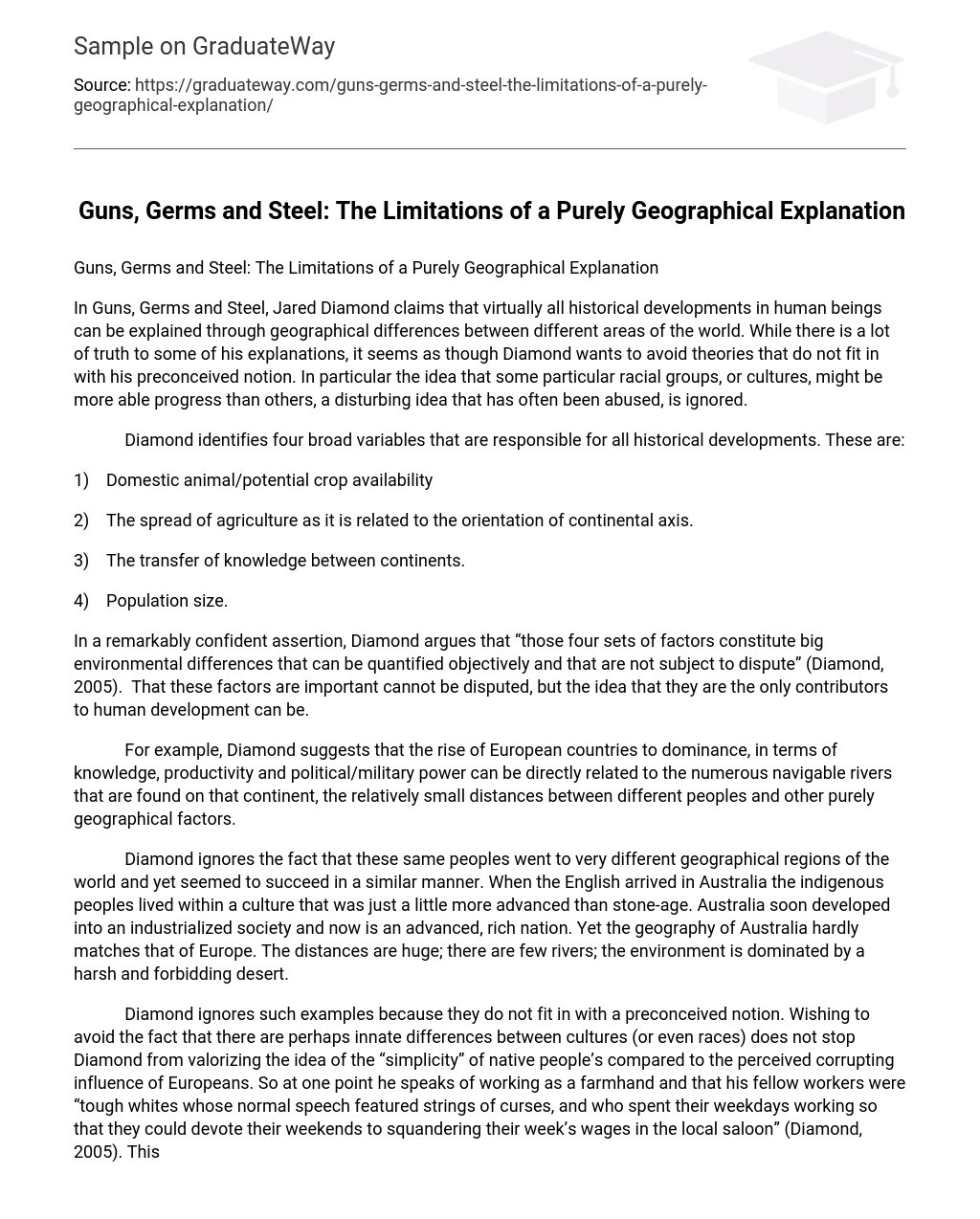In Guns, Germs and Steel, Jared Diamond claims that virtually all historical developments in human beings can be explained through geographical differences between different areas of the world. While there is a lot of truth to some of his explanations, it seems as though Diamond wants to avoid theories that do not fit in with his preconceived notion. In particular the idea that some particular racial groups, or cultures, might be more able progress than others, a disturbing idea that has often been abused, is ignored.
Diamond identifies four broad variables that are responsible for all historical developments. These are:
1) Domestic animal/potential crop availability
2) The spread of agriculture as it is related to the orientation of continental axis.
3) The transfer of knowledge between continents.
4) Population size.
In a remarkably confident assertion, Diamond argues that “those four sets of factors constitute big environmental differences that can be quantified objectively and that are not subject to dispute” (Diamond, 2005). That these factors are important cannot be disputed, but the idea that they are the only contributors to human development can be.
For example, Diamond suggests that the rise of European countries to dominance, in terms of knowledge, productivity and political/military power can be directly related to the numerous navigable rivers that are found on that continent, the relatively small distances between different peoples and other purely geographical factors.
Diamond ignores the fact that these same peoples went to very different geographical regions of the world and yet seemed to succeed in a similar manner. When the English arrived in Australia the indigenous peoples lived within a culture that was just a little more advanced than stone-age. Australia soon developed into an industrialized society and now is an advanced, rich nation. Yet the geography of Australia hardly matches that of Europe. The distances are huge; there are few rivers; the environment is dominated by a harsh and forbidding desert.
Diamond ignores such examples because they do not fit in with a preconceived notion. Wishing to avoid the fact that there are perhaps innate differences between cultures (or even races) does not stop Diamond from valorizing the idea of the “simplicity” of native people’s compared to the perceived corrupting influence of Europeans. So at one point he speaks of working as a farmhand and that his fellow workers were “tough whites whose normal speech featured strings of curses, and who spent their weekdays working so that they could devote their weekends to squandering their week’s wages in the local saloon” (Diamond, 2005). This is of course a fair enough description of many young working men throughout the world, from contrasting cultures and systems. But Diamond goes on to describe a member of the Blackfoot Indian Tribe who “behaved very differently from the coarse miners – being polite, gentle, responsible, sober and well spoken” (Diamond, 2005). In one sense Diamond falls into the trap of perceiving a less advanced culture as something of a “noble savage”, as per Rousseau (1987).
He sees the people who inhabit the less geographically promising areas of the world, or at least those who are native to them, as in some way morally superior to those from the West. Diamond bases this opinion on a romanticized notion of these people that does not seem to stem from understanding but rather from imagination.
Diamond argues that all historical development is geographically based but refuses to admit that there are many other factors that seem to influence it. For example, how can the inspired “genius” who transforms both his own society and those around the world, be explained? Was Thomas Edison produced by the geographical environment in which he lived or was at least some of his work catalyzed by an innate brilliance? The idea that some individuals may in fact be inherently “superior” (in the sense of higher intelligence, more ability) than others is as alien to Diamond as the fact that some cultures may be more able to develop than others.
He also seems to ignore the fact that many traditional societies are in fact superbly adapted to their environments and that European-based (now American-based) ideas of development are inappropriate to them. For example, many native peoples within the Indian sub-continent and into Asia have built what appear to be quite flimsy houses on stilts. Europeans arrived and showed them a “better” way of building houses that enabled them to be built at ground level. What the Europeans did not understand was that the houses were on stilts in order to place them above the level of the mosquitoes that could spread many different diseases among the people (Desowitz, 1993). These insects come out at night – precisely the time that the people are most likely to be in the houses.
To conclude, Diamond’s purely geographical explanation for human development avoids discussing the very real differences between different cultures and peoples which exist at the human level. The idea that all development can be seen in broad progress on agricultural, knowledge-based, industrial and political development is essentially a Eurocentric paradigm that ignores the very real achievements of those whose “lack of progress” Diamond seems to want to hide behind a geographical explanation.
____________________________________
Works Cited
Desowitz, Robert. The Malaria Capers: More Tales of Parasites and People, Research and Reality. WW Norton, New York: 1993.
Diamond, Jared. Guns, Germs and Steel: The Fates of Human Societies. WW Norton, New York: 2005.
Rousseau, Jean-Jacques. Basic Political Writings. Hackett Publishing Company, New York: 1987.





